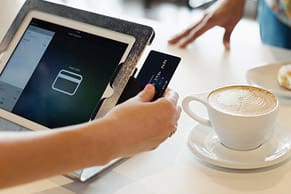Credit card issuers have historically been slow to adopt contactless payment, a way to make credit card purchases without any physical contact with staff or terminals. Now, as this payment method becomes increasingly popular, issuers are adapting. As customers use cash less and less, seeking safe and secure ways to pay for their purchases, businesses need to adapt by providing new methods like contactless payment.
Businesses that adopt contactless payments can strengthen customer loyalty and enhance their competitive edge. It is also a way to reduce cash on hand and the responsibilities that come with handling that cash. These are just a few of benefits of accepting contactless payments.
What Is a Contactless Payment?
Contactless payment is a way to make purchases without physically passing a card to another person or swiping it through a machine yourself. This technology, also referred to as “tap to pay,” enables users to tap their phone or card at an enabled terminal to authorize payment.
How do customers know if their card is contactless? Cards that support this payment method have a symbol on the front or back of their card that looks like a radio wave or a Wi-Fi symbol turned on its side. Customers can use contactless payments at an expanding list of participating retailers.
Key Takeaways
- Contactless payment uses radio frequency identification (RFID) technology and near-field communication (NFC) to offer customers a more secure payment method than the traditional method of swiping a credit card.
- Contactless payments can be used at any retailer with point-of-sale (POS) systems equipped with the technology if the customer has a card or digital wallet that supports it.
- Contactless payment apps include Android Pay, Apple Pay, Google Pay and Samsung Pay.
Contactless Payment Explained
Contactless payment is a secure payment method that allows customers to pay for goods and services using their smartphone, debit card or credit card using radio frequency identification (RFID) technology and near-field communication (NFC). Smartphone apps and mobile wallets have increased the popularity of contactless transactions.
Shoppers can use contactless payment wherever there is a point-of-sale (POS) terminal set up with contactless payment technology, which today includes most major brick-and-mortar stores, from coffeeshops to big-box retailers.
How Contactless Payments Work
Contactless payments let customers use debit or credit cards enabled with a form of RFID technology (chip cards) to purchase goods and services. This technology doesn't require the customer to use their personal identification number (PIN) or swipe and sign for a purchase. Retailers that accept contactless payment will have point-of-sale (POS) systems that support the newer payment method, with some showing the wave symbol mentioned above.
To use contactless payment, customers need to hold the card close to the machine's contactless payment symbol when the retailer’s POS system asks for payment. When the card is within close proximity, it will transmit data electronically from the chip to the customer’s financial institution. If the POS machine accepts the payment, it will notify the customer with either a beep, checkmark or green light. The transaction is considered complete once the system receives approval.
Consumers also have the option to connect their credit or debit card to their mobile device, including their smartphone, smartwatch or fitness tracker. To do so, users need to download a payment app that can store their payment information securely, then tap their device and confirm their identity to make purchases.
Contactless Payment Technology
Consumers can use both RFID-enabled cards or e-wallets installed on their mobile devices, also known as mobile wallets, to make contactless payments. Both methods may have transaction limits set by their bank or card issuer that vary according to the financial institution. Retailers may also have limits in place to protect against fraud, though many still allow large transaction amounts. Some payments of a certain value may also require a signature for the transaction to be approved. For example, some Apple Pay customers in the US might need to provide a signature for purchases over $50.
-
Contactless Cards
More specifically, contactless payment systems (including cards) use NFC, a type of technology that falls within RFID. NFC will only work when there is a small distance between objects — in this case, the card or device and the POS terminal. The idea behind that requirement is that there's no risk of your card or device accidentally paying for someone else's transaction.
-
E-wallets
Also known as mobile wallets, e-wallets are apps on mobile devices that also use NFC technology. Users need to download an app like Apple Pay or Google Pay, then link their credit cards to those accounts to make contactless payments with their smartphone, smartwatch or other wearable device.
Contactless ATMs also let banking customers withdraw cash with a tap of their card on the machine instead of swiping and entering their PIN.
Users can also link their debit cards to these devices to withdraw cash at ATMs. Most major banks require their own proprietary apps to use cardless ATMs, but some institutions’ cards can be used with different types of e-wallets.
Where Can Contactless Payments Be Used?
Consumers interested in trying contactless payments can find them at most retailers in the U.S. Retailers will usually indicate — typically at the entrance to their stores — whether they accept contactless payments like mobile wallets. Plenty of retailers will also have NFC-enabled payment terminals, and users can tell by looking for the Wi-Fi-like symbol.
Many major retailers also have contactless payment options within their apps. For instance, Walmart’s app allows customers to scan a QR code at checkout and pay with a card linked to their account. Other retailers like Starbucks allow customers to make payments directly through their mobile app.
Most major U.S. card issuers have already implemented contactless technology in chip cards, though customers who have cards that have not yet been outfitted with the technology can still use mobile wallets.
Advantages and Disadvantages of Contactless Payment
Contactless payment methods reduce the amount of risk for both retailers and consumers because the technology is more secure than using magnetic strips to transmit information. Criminals can clone information from these magnetic strips, whereas NFC technology sends encrypted data, making it harder to steal.
Not exchanging a card or cash is also a more sanitary way to pay for goods or services. This is part of the reason contactless transactions became much more popular in the U.S. during the coronavirus pandemic in 2020. Contactless payments are also faster, taking about half the time to process as chip cards, and could become easier once consumers get the hang of it.
If information is stolen, consumers can dispute any fraudulent transactions and request replacement cards.
Another downside is that contactless payments aren't readily available to everyone. Those who don’t have bank accounts or access to smart devices or similar technology will still need to rely on cash. Retailers who have a no-cash policy may want to consider that they're keeping out some customers who can only pay in cash, particularly elderly people and lower-income customers. Plus, while transaction limits may be increasing, they may still be lower than if someone confirms a purchase by using their PIN or signature.
History of Contactless Payment
Contactless payment started in the late twentieth century when a few retailers adopted the technology. One of the world’s first contactless systems was implemented in Seoul, South Korea, in 1995, when the UPass system offered public transit riders a convenient way to pay for their bus rides. Since then, the method has spread worldwide — the London transit agency started offering commuters the choice to use contactless debit and credit cards as payment methods in 2014, in addition to their prepaid contactless Oyster Card system.
The U.S. also has contactless payments, and it’s been surging in popularity in recent years. For instance, Visa reported in mid-2020 that contactless payments for everyday transactions such as those at grocery stores had risen more than 100% year-over-year.
A similar 2020 study from Mastercard also showed 40% growth in contactless transactions around the world during the first quarter of 2020. Considering contactless usage grew 150% in the U.S. from 2019 to 2020, this payment method is likely to continue to become more commonplace.
Examples of Contactless Payment
In addition to banks and other financial institutions, third party apps also support contactless payments.
Some earlier devices may not support these, but these some apps that enable payments through NFC technology include:
- Apple Pay: iOS devices usually come with this app that stores credit and debit cards to use online or at brick-and-mortar locations. Users can also send money to family and friends through Apple Pay.
- Google Pay: This app merges Google Wallet and Android Pay, allowing users to make payments securely by sharing an encrypted number with the retailer that’s tied to a payment card. Google Pay users can also send and receive money through the app, earn rewards and take advantage of promotions.
- Samsung Pay: Samsung Pay works much like Apple Pay and Google Pay, and offers similar cash back and reward opportunities on eligible purchases as the latter.
Contactless Payment Security
During contactless transactions, a unique one-time token is sent from your card or smart device to the POS terminal during each transaction. This token doesn’t contain any of your card information, and the token can’t be used to make additional purchases. It’s the same technology that the chip on your credit or debit card uses.
As an additional security measure, mobile wallets may require the user to verify the purchase by scanning their fingerprint, using facial recognition or inputting a password or PIN before the payment can go through. All of these precautions make it a very secure payment method.
Go Contactless with NetSuite
Businesses that want to use contactless payments in their operations can use NetSuite to automate their financials. NetSuite’s SuiteCommerce unifies online and offline shopping channels and offers a secure payment connector that works seamlessly with major payment processors — and the ERP accounting functionality saves time and money by automatically reconciling transactions and managing the general ledger. Business owners and leaders can conduct contactless transaction processing from issuers such as Visa, MasterCard, American Express and Discover with PCI-validated point-to-point encryption.
Contactless payments are increasing in popularity, so businesses need to support them to ensure that customers looking for faster and more secure payment methods are satisfied. The technology is there for companies to adopt contactless right now, and they should get onboard before consumers start to avoid stores that don’t offer contactless payment.
Top
Ecommerce
Software
Contactless Payment FAQs
What will happen to cash payments?
While there is an increase in card-focused payments, cash won’t disappear completely. For certain demographics like elderly communities, cash is still considered king, especially for those who don’t have access to mobile technology. There are also a significant number of adults who don’t have sufficient access to banking services to enroll in contactless programs.
When did contactless payment start?
Contactless payments first surfaced in the 1990s, but were only supported by a small number of businesses that had the required technology. In more recent years, retailers, banks and credit card companies have increasingly adopted contactless payment methods.
Can a customer be charged twice?
POS terminals that can handle contactless transactions will communicate with only one card at any time, so there is no chance of being charged twice for a single purchase. Users who have more than one card in their physical wallet should take out and tap the card they want to use.
When would a signature be required for a contactless payment?
Most card issuers don't require signatures for low transaction values, often $25 or less. For transactions larger than $25, retailers can opt out of requiring signatures if they are willing to take on the additional risk, since they may not maintain full chargeback rights.









